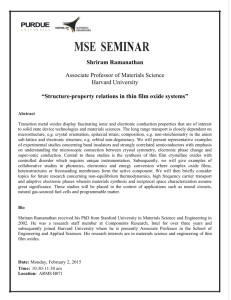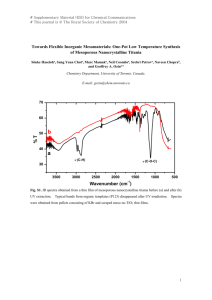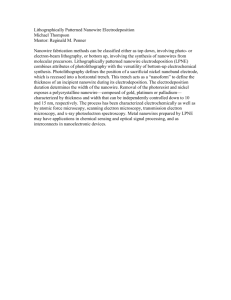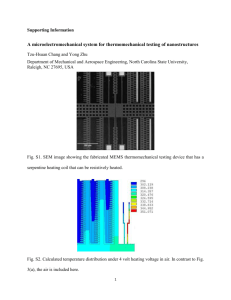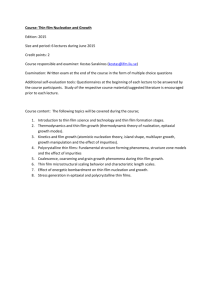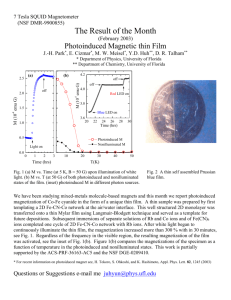Nano scale electrical properties of Ag
advertisement
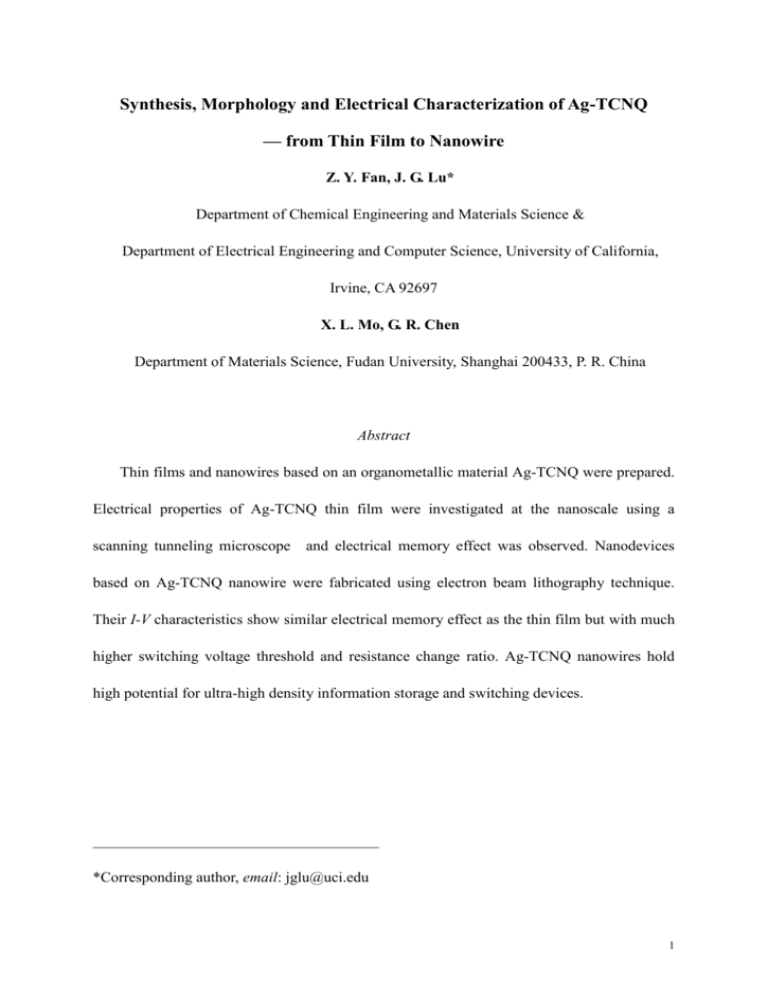
Synthesis, Morphology and Electrical Characterization of Ag-TCNQ — from Thin Film to Nanowire Z. Y. Fan, J. G. Lu* Department of Chemical Engineering and Materials Science & Department of Electrical Engineering and Computer Science, University of California, Irvine, CA 92697 X. L. Mo, G. R. Chen Department of Materials Science, Fudan University, Shanghai 200433, P. R. China Abstract Thin films and nanowires based on an organometallic material Ag-TCNQ were prepared. Electrical properties of Ag-TCNQ thin film were investigated at the nanoscale using a scanning tunneling microscope and electrical memory effect was observed. Nanodevices based on Ag-TCNQ nanowire were fabricated using electron beam lithography technique. Their I-V characteristics show similar electrical memory effect as the thin film but with much higher switching voltage threshold and resistance change ratio. Ag-TCNQ nanowires hold high potential for ultra-high density information storage and switching devices. _____________________________________ *Corresponding author, email: jglu@uci.edu 1 1. INTRODUCTION Organometallic materials such as Cu-tetracyanoquinodimethane (TCNQ) and Ag-TCNQ have unique electrical properties. Electrical switching and memory effect have been reported previously [1,2], and their applications for optical and electrical recording media are proposed [1-5]. To use metal-TCNQ as high density electrical memory material, local electrical properties of material need to be studied. In our experiments, investigation of the electrical properties of Ag-TCNQ is realized by two methods: Ag-TCNQ thin films were prepared and scanning tunneling microscopy (STM) was used to characterize their electrical properties; and Ag-TCNQ nanowires were synthesized, contact electrodes were fabricated using electron beam lithography and I-V characteristics were measured. Experiments showed nanometer scaled electrical switching and memory effect of Ag-TCNQ, which demonstrated the potential of Ag-TCNQ as a promising material for ultra-high density information storage. 2. EXPERIMENT 2.1 Ag-TCNQ thin film and nanoscale electrical properties Ag-TCNQ thin film was prepared by thermal evaporation. A 10 nm Ag layer was deposited on a glass substrate coated with Indium Tin Oxide (ITO). Base pressure for evaporation was 1.5×10-3 Pa and evaporation rate was 0.5 nm/s. Afterwards a 15 nm TCNQ layer was evaporated onto the Ag thin film at an evaporation rate of 0.1 nm/s. Sample was then baked in vacuum for 30 min at 370 K to facilitate the following solid reaction [1]: Ag0 + TCNQ0 ↔ Ag-TCNQ During baking, TCNQ residue was thermally evaporated, so the ratio of Ag and TCNQ was 2 1:1. Scanning probe microscopes have been widely used to study local electrical properties of materials [6-8]. To characterize nanoscale electrical properties of Ag-TCNQ, a home built STM was developed. A schematic measurement circuit is shown in Fig. 1a. Tunneling current of 0.9 nA was maintained between the STM tip and Ag-TCNQ thin film by electronic feedback system. Later, the feedback was turned off for 3 ms and a DC sweep voltage was applied over tip and sample. Fig. 1b shows the corresponding I-V characteristic on thin film after subtracting voltage drop on the load resistor R. The I-V hysteresis in Fig. 1b shows electrical switching and memory effect. Arrows in Fig. 2b indicates the direction of voltage sweep. The threshold Vt for switching is close to 0.16 V. Before Vt (labeled as segment ‘1’), the Ag-TCNQ thin film is in high resistance state, RH = 50 MΩ. After Vt (segment ‘2’), the resistance of thin film drops so fast that the voltage on thin film decreases while current increases. Trace 3 shows current saturates due to the limit of the measurement circuit. When voltage is being swept back to 0 V (segment ‘4’), the resistance of Ag-TCNQ thin film seems still in low resistance state, RL = 500 KΩ, the ratio of RH over RL is 100. In fact, the tunneling resistance (Rt) has not been separated out in this estimate. Taking a reasonable value for Rt close to RL, the actual resistance ratio should be much larger than 100. If high resistance state and low resistance state are used to represent binary states “0” and “1”, respectively, Ag-TCNQ thin film could be a candidate for application in information storage. 2.2 Ag-TCNQ nanowire and nanodevice 3 One-dimensional (1D) nanostructures, such as nanotubes, nanowires, etc. are triggering more and more interests for their potential application as the building blocks for nanoelectronics and optoelectronics [9-12]. Compare with thin film materials, nanowires have the advantage in creating ultra-high density devices by using bottom up fabrication techniques [13-15]. Here we report the synthesis of Ag-TCNQ nanowires and electrical transport measurements of Ag-TCNQ nanowire devices. Ag-TCNQ nanowires were synthesized following these procedures. A 10 nm Ag film was deposited first on a silicon (111) substrate in a thermal evaporator. Base pressure for evaporation was 2×10-3 Pa. Then the Ag thin film was placed together with 15 mg of 7,7,8,8-TCNQ powder (98%, Aldrich) in a quartz tube (2.5 cm diameter, 15 cm length). After pumping down to 2×10-3 Pa, the quartz tube was molten and sealed to enclose the substrate and TCNQ. The sealed tube was then placed into a furnace. The temperature was ramped up to 368 K in 5 min and kept there for 2 hours. Finally, the sample was taken out of the quartz tube and baked at 373 K at 2.0×10-3 Pa pressure for 0.5 hour to remove the TCNQ residue. SEM image (Fig. 2) shows a vertically grown Ag-TCNQ nanowire with a typical diameter around 80 nm. Synthesized Ag-TCNQ nanowires were then dispersed into isopropyl alcohol (IPA) and dispersed onto a silicon substrate which had predefined alignment marks. High magnification optical microscope (Nikon Optiphot EPI, 1500×) was used to locate the position of nanowires and their coordinates were calculated with respect to the alignment marks. The lithography pattern for contact electrodes was then designed based on the coordinates. The resists for electron beam lithography (EBL) were spin coated to the substrate then exposed in 4 an e-beam writer (Jeol JBX-5D11) with electron energy of 50 keV. Exposed resist was developed, and then electrodes were deposited with Au (110 nm) on top of Ti adhesive layer (20 nm) using ebeam evaporator. Finally, lift-off was done in acetone. A SEM image of a device is shown in Fig. 3a. The current-voltage characteristics of Ag-TCNQ nanowire were obtained as shown in Fig. 3b. A 22 MΩ load resistor (R) was placed in series with the sample to protect it from current burst. A schematic of measurement circuit is presented in the inset of Fig. 3b. I-V curves were obtained by sweeping up and down a DC voltage applied between electrodes A and B as labeled in Fig. 3a, the voltage ranges from 0 V to 8 V. Fig. 3b shows the reproducible I-V characteristic of Ag-TCNQ nanowire. I-V hysteresis loop demonstrates electrical switching and memory effect. Electrical switching indicates transition from a high resistance state to a low resistance state. The threshold voltage for the resistance switching is 7.5 V as shown in Fig. 3b. Since the length of the Ag-TCNQ nanowire between electrodes A and B is 1µm, threshold electric field is on the order of 106 V/m. In the high resistance state, the resistance of nanowire is around 1000 GΩ (1012 Ω), while it drops to 50 MΩ in the low resistance state. The resistance changes (on-off ratio) by four orders of magnitude, which is much higher than the thin film result mentioned before. Again taking into account the voltage drop on the 20 MΩ load resistor, the actual on-off ratio of switching for the nanowire should be higher. I-V characteristics on the nanowire device also demonstrate electrical memory effect. As shown in Fig. 3b, the resistance of nanowire is kept in low resistance state when voltage is being swept back to 0 V. Similar to the discussion on Ag-TCNQ thin film, if high resistance 5 state and low resistance state represent binary states “0” and “1”, Ag-TCNQ nanowires can be used as an organic electrical memory material due to the large resistance change between the two states. If Ag-TCNQ nanowires are synthesized in precise orientation and integration, nanodevices array based on Ag-TCNQ nanowires can achieve as high as 1010 bits/cm2 in information storage. 3. Discussion and Conclusion The electrical switching effect of metal-TCNQ charge transfer complex was explained as an electric field induced reversible phase transition [1,3]. This phase transition yields partial neutral species of metal and TCNQ from metal-TCNQ and thus builds conduction channels in the material which substantially increases conductivity [1,3]. We report a switching threshold voltage for nanowire around 7.5 V and for thin film only 0.16 V. The threshold electric fields for thin film and nanowire can be obtained from the thickness of thin film and the length of nanowire between the contact electrodes, which are 20 nm and 0.8 µm, respectively. So the threshold fields are 8.0×106 V/m for thin film and 9.3×106 V/m for nanowire. They agree well with each other and support the field induced phase transition model. However, whether the switching mechanisms for Ag-TCNQ thin film and nanowire are exactly the same need to be further investigated. In summary, electrical properties of Ag-TCNQ thin films and nanowires are presented. Electrical switching and memory effect were observed for both cases. Since nanowires can be used in high density integration of nanodevices and they have much higher on-off ratio than thin film, Ag-TCNQ nanowire is a promising material for future ultra-high density information storage and nanoscale switching devices. 6 ACKOWLEDGEMENT The authors are grateful to Mr. Dawei Wang for assistance in nanofabrication and Drs. B. Diouf and J. Philip for helpful discussions. This work is supported by UC Irvine, Fu Dan University, and a NSF CAREER award. REFERENCES [1] R. S. Potember, T. O. Poehler and D. O. Cowan // Appl. Phys. Lett., 34 (1979) 405. [2] X. G. Wan, D. Y. Chen, Y. M. Jiang and Z. Y. Hua // Phys. Stat. Sol., 181 (2000) R13. [3] S. Q. Sun, X. Y. Xu, P. J. Wu and D. B. Zhu // J. Mater. Sci. Lett., 17 (1998) 719. [4] R. C. Hoffman and R. S. Potember // Appl. Optics, 28 (1989) 1417. [5] J. Gong and Y. Osada // Appl. Phys. Lett., 61 (1992) 2787. [6] J. J. Urban, J. E. Spanier, L. Ouyang, W. S. Yun and H. Park // Adv. Mater., 15 (2003) 423. [7] A. A. Pomarico, D. Huang, J. Dickinson, A. A. Baski, R. Cingolani, H. Morkoc and R. Molnar // Appl. Phys. Lett., 82 (2003) 1890. [8] C. S. Jiang, H. R. Moutinho, J. F. Geisz, D. J. Friendman and M. M. Al-Jassim // Appl. Phys. Lett., 81 (2002) 2569. [9] Y. Huang, X. Duan, Y. Cui, L. J. Lauhon, K. H. Kim and C. M. Lieber // Science, 294 (2001) 1313. [10] A. Bachtold, P. Hadley, T. Nakanishi and C. Dekker // Science, 294 (2001) 1317. [11] X. Duan, Y. Huang, Y. Cui, J. Wang and C. M. Lieber // Nature, 409 (2001) 66. 7 [12] X. Duan, Y. Huang, R. Agarwal and C. M. Lieber // Nature, 421 (2003) 241. [13] A. J. Yin, J. Li, W. Jian, A. J. Bennett and J. M. Xu // Appl. Phys. Lett., 79 (2001) 1039. [14] K. Nielsch, R. B. Wehrspohn, J. Barthel, J. Kirschner, S. F. Fischer, H. Kronmüller, T. Schweinböck, D. Weiss and U. Gösele // J. MAGN. MAGN. MATER., 249 (2002) 234. [15] M. S. Sander, A. L. Prieto, R. Gronsky, T. Sands and A. M. Stacy // Adv. Mater., 14 (2002) 665. 8 Figure Captions: Fig. 1. Electrical property of Ag-TCNQ thin film characterized by STM. (a) schematic of measurement circuit (b) I-V characteristic of Ag-TCNQ thin film. Fig. 2. SEM images of a single vertical grown Ag-TCNQ nanowire with diameter ~80 nm. Fig. 3. Nanodevice based on Ag-TCNQ nanowire: (a) SEM image of a Ag-TCNQ nanodevice, electrode A and B are connected to the measurement circuit (b) I-V hysteresis characteristic of nanodevice shows electrical switching and memory effect. The inset plot shows a schematic of the circuit. 9 Fig. 1 10 Fig. 2 11 Fig. 3 12

